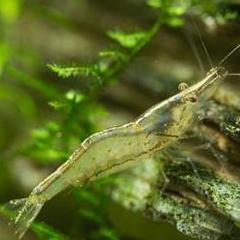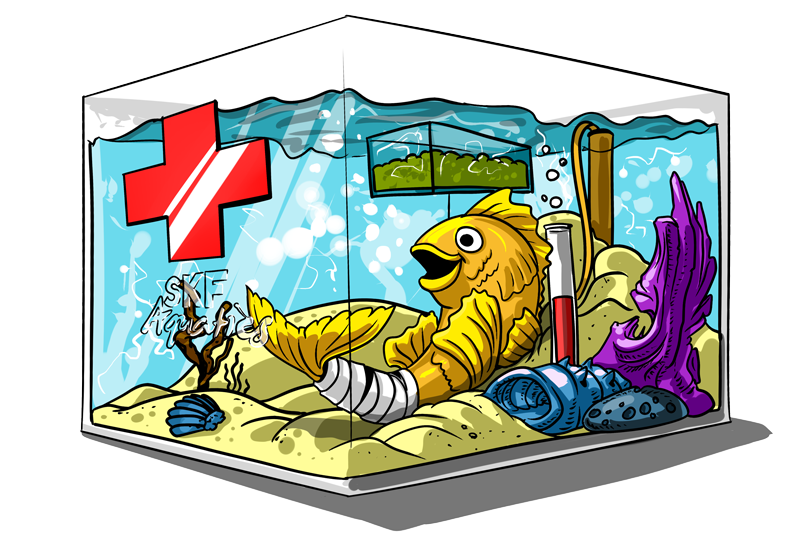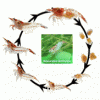Search the Community
Showing results for tags 'sick'.
-
The Importance of Owning a Quarantine Tank A quarantine or hospital tank is an important part of owning an aquarium. Quarantine tanks should be used by anyone introducing new inhabitants (fish, shrimp, etc…) to a tank, but unfortunately, not all owners are able to use these specialized tanks. When a new inhabitant is introduced into an aquarium, there is the potential for it to bring diseases or parasites and vice versa. For example, new fish tend to be stressed from the transportation process. Because of this, new fish are more vulnerable to any disease or parasites already present in the existing aquarium environment. In other words, disease and parasites can work both ways, harming both the new fish and harming fish already present in the environment. A quarantine tank helps to protect your aquarium and allows new fish to regain their strength following their journey. It’s important to make an investment in one of these tanks if you’re serious about fish or any aquatic animal ownership. In most cases, people don’t purchase a quarantine tank because they either don’t understand its importance or they don’t have the additional money/space for another tank. A quarantine tank also requires additional maintenance. However, you don’t have to invest in a particularly large or expensive tank. You may end up saving money in the long run by preventing your fish and shrimp from getting sick or ill. Most people who invest in a quarantine tank end up realizing there are significant benefits. These tanks not only prevent the spread of disease and parasites, but also help your new inhabitants to adjust to the new water and food they’ll be exposed to. When you’re not quarantining before introduction into the larger tank, you can also use it as a treatment tank. For example, if you have sick or infected shrimp, you can separate them from the larger population and place them inside the quarantine tank. This allows you to carefully attend to your sick shrimp without worry than your healthy shrimp will also become ill. Under some circumstances, you can also use the quarantine tank as a breeding tank, a tank to raise newly hatched fry and shrimplets, and as a place to seclude any of your inhabitants who are being harassed. There are additional benefits to using a quarantine tank. First, it’s easier and cheaper to medicate sick inhabitants when you use a quarantine tank. By preventing a larger outbreak, you can minimize the medical costs by limiting your treatment to one or two sick inhabitants. It’s also far easier to maintain the water quality for newly introduced fish or shrimp. In heavily populated tanks, it’s difficult to keep the water quality at optimal levels. In a more limited quarantine tank, you can more effectively maintain the optimum water conditions. If your inhabitants are exhibiting any signs of trouble adjusting to its environment, you can perform even more frequent water changes to guarantee the water quality is optimum. However, in general, a quarantine tank is a good investment because it allows you to keep any eye on specific tank inhabitants more easily. When a fish or shrimp is isolated from larger groups, it’s easier find and inspect. They will also be less likely to hide in a smaller tank. For all these reasons, quarantine tanks are the perfect solution for aquatic owners needing to keep inhabitants isolated. Typically speaking, you’ll want to buy a 30-40L (approx. 9 gallon) tank for use as a quarantine tank. This size is perfect for both freshwater and saltwater environments. Afterward, you’ll want to set up the tank to operate properly. Use a fluorescent light to illuminate the area, keep a heater to warm the water, and use rocks that can be easily scrubbed of any waste. PVC and plastic tubes can be used to provide additional cover. To keep the tank appropriately filtered, use a sponge filter. These filters require you to remove, disinfect, and rinse them in-between uses. Also, since quarantine tanks are temporary holding areas, they typically don’t have a substrate. This will let you clean and disinfect them more easily. The disinfection process itself is not too complicated. You can remove the equipment inside when the tank is not in use. Using a mild unscented bleach solution, you can scrub both the equipment and the internal walls of the tank. However, make sure to remove all traces of bleach before refilling the tank and placing any fish in there. Drying out the tank is another way to kill many of the waterborne pathogens that commonly infest a tank. Use a separate siphon for your quarantine tank than you use for your normal tank, and disinfect it when you disinfect the rest of the tank’s equipment. With fish, the actual length of time you keep them quarantined can vary, but typically it takes between two to four weeks to either introduce a new fish or rehab a sick one. Within that time frame, a copper sulfate treatment can be used to treat parasites. This process can last anywhere from two to three weeks. Keep an eye on your fish. If they have red spots or ragged fins, there’s a chance there’s a bacterial infection going on, which will require additional treatments. Also replace between 10 and 15% of the water every other day to guarantee the quality of your water is at its best. That said, if you also keep shrimp, either setup a second hospital tank for them or ensure you do a proper clean after use. To shrimp, the majority of copper based solutions can be fatal.
- 1 review
-
- 3
-

-
- new livestock
- sick
-
(and 4 more)
Tagged with:
-

New Library Article - Hospital (Quarantine) Tanks
NoGi posted a topic in General Questions/Discussions
The Importance of Owning a Quarantine Tank A quarantine or hospital tank is an important part of owning an aquarium. Quarantine tanks should be used by anyone introducing new inhabitants (fish, shrimp, etc…) to a tank, but unfortunately, not all owners are able to use these specialized tanks. When a new inhabitant is introduced into an aquarium, there is the potential for it to bring diseases or parasites and vice versa. For example, new fish tend to be stressed from the transportation process. Because of this, new fish are more vulnerable to any disease or parasites already present in the existing aquarium environment. In other words, disease and parasites can work both ways, harming both the new fish and harming fish already present in the environment. A quarantine tank helps to protect your aquarium and allows new fish to regain their strength following their journey. It’s important to make an investment in one of these tanks if you’re serious about fish or any aquatic animal ownership. In most cases, people don’t purchase a quarantine tank because they either don’t understand its importance or they don’t have the additional money/space for another tank. A quarantine tank also requires additional maintenance. However, you don’t have to invest in a particularly large or expensive tank. You may end up saving money in the long run by preventing your fish and shrimp from getting sick or ill. Most people who invest in a quarantine tank end up realizing there are significant benefits. These tanks not only prevent the spread of disease and parasites, but also help your new inhabitants to adjust to the new water and food they’ll be exposed to. When you’re not quarantining before introduction into the larger tank, you can also use it as a treatment tank. For example, if you have sick or infected shrimp, you can separate them from the larger population and place them inside the quarantine tank. This allows you to carefully attend to your sick shrimp without worry than your healthy shrimp will also become ill. Under some circumstances, you can also use the quarantine tank as a breeding tank, a tank to raise newly hatched fry and shrimplets, and as a place to seclude any of your inhabitants who are being harassed. There are additional benefits to using a quarantine tank. First, it’s easier and cheaper to medicate sick inhabitants when you use a quarantine tank. By preventing a larger outbreak, you can minimize the medical costs by limiting your treatment to one or two sick inhabitants. It’s also far easier to maintain the water quality for newly introduced fish or shrimp. In heavily populated tanks, it’s difficult to keep the water quality at optimal levels. In a more limited quarantine tank, you can more effectively maintain the optimum water conditions. If your inhabitants are exhibiting any signs of trouble adjusting to its environment, you can perform even more frequent water changes to guarantee the water quality is optimum. However, in general, a quarantine tank is a good investment because it allows you to keep any eye on specific tank inhabitants more easily. When a fish or shrimp is isolated from larger groups, it’s easier find and inspect. They will also be less likely to hide in a smaller tank. For all these reasons, quarantine tanks are the perfect solution for aquatic owners needing to keep inhabitants isolated. Typically speaking, you’ll want to buy a 30-40L (approx. 9 gallon) tank for use as a quarantine tank. This size is perfect for both freshwater and saltwater environments. Afterward, you’ll want to set up the tank to operate properly. Use a fluorescent light to illuminate the area, keep a heater to warm the water, and use rocks that can be easily scrubbed of any waste. PVC and plastic tubes can be used to provide additional cover. To keep the tank appropriately filtered, use a sponge filter. These filters require you to remove, disinfect, and rinse them in-between uses. Also, since quarantine tanks are temporary holding areas, they typically don’t have a substrate. This will let you clean and disinfect them more easily. The disinfection process itself is not too complicated. You can remove the equipment inside when the tank is not in use. Using a mild unscented bleach solution, you can scrub both the equipment and the internal walls of the tank. However, make sure to remove all traces of bleach before refilling the tank and placing any fish in there. Drying out the tank is another way to kill many of the waterborne pathogens that commonly infest a tank. Use a separate siphon for your quarantine tank than you use for your normal tank, and disinfect it when you disinfect the rest of the tank’s equipment. With fish, the actual length of time you keep them quarantined can vary, but typically it takes between two to four weeks to either introduce a new fish or rehab a sick one. Within that time frame, a copper sulfate treatment can be used to treat parasites. This process can last anywhere from two to three weeks. Keep an eye on your fish. If they have red spots or ragged fins, there’s a chance there’s a bacterial infection going on, which will require additional treatments. Also replace between 10 and 15% of the water every other day to guarantee the quality of your water is at its best. That said, if you also keep shrimp, either setup a second hospital tank for them or ensure you do a proper clean after use. To shrimp, the majority of copper based solutions can be fatal. View full article-
- 2
-

-
- illness
- new livestock
-
(and 4 more)
Tagged with:
-
Hey SKF, My snowball and my rcs colonies are perishing - succumbing to bacterial infection I believe. I moved house not very long ago and for some reason my YCS and CRS have taken it in stride, not lost any berries or shrimplets at all as far as I can tell. I'm not sure what has gone wrong with those other 2 colonies - I think it may relate to some of the cleaning process of the gravel/tanks or whatnot. The RCS have a purplish/bluish section on their abdomen and the older ones are the first/quickest to give up but others are following, most have poor colour. They first became ill after being placed in a food-grade bucket I bought from bunnings (but probably didn't wash well enough.. who knows what was the reason as other shrimps did perfectly well in the exact same buckets) My snowball colony was obtained a few months ago but were compromised by being placed in a tank of doom from the getgo, I never saw any saddles and 4 of the 20 I bought had died over that period. Since moving them to a new setup (with completely new filter/media, new gravel and tank) they have been dying 1 or 2 per day and I now have 5 or 6 left. Due to time constraints I have failed to mitigate the illnesses in either of these 2 colonies and I'm going to bin the rest of them so I can focus on my other colonies and once they are thriving I will consider setting up other tanks again, ANYWAY - you win some and you lose some but I know my shrimp breeding hobby will bounce back stronger, My future tanks will be setup much better given planning and time to do it properly. I joined the forum after having accidentally bred thousands of mixed-grade RCS in a large 4 foot planted tank. I sold many of these very cheaply and thought "wow how cool I can pay for my aquarium hobby as I go!". It took some months before I realised truly how fun shrimp breeding is. The process of selection/culling is so rewarding and despite lots of hiccups I have still made progress improving the quality of my shrimps. I am especially proud of my YCS colony as I struggled and struggled when I first got them, barely managing to get them to reproduce but over the course of the year I now have "hardier" shrimps while keeping the same colour quality as I initally bought. I look forward to sharing experiences and knowledge on SKF in the year to come. I really want to thank all the members of SKF who have contributed over the course of 2015 to make this such a wonderful and helpful community I have learnt a lot. I won't single anyone out for thanks but there are people here who go well out of their way to guide noobs like me through their shrimpkeeping difficulties and they deserve a big pat on the back. I'd also like to thank the wonderful sponsors here. and a huge thankyou to Nogi for putting in so much time to manage the forums here! Cheers SKF and may the forum continue to grow and thrive into the new year to come. love n peace will
- 5 replies
-
- 4
-

-
- bacterial infection
- sick
-
(and 7 more)
Tagged with:


